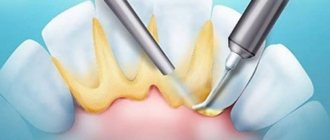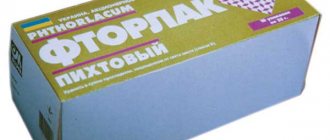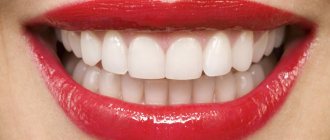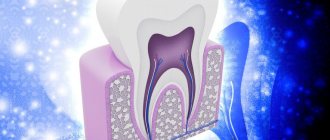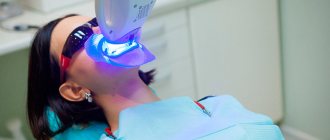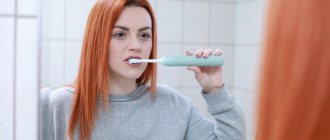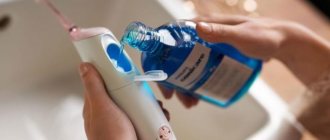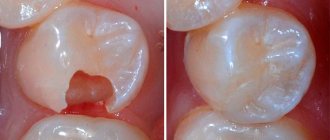- What are dental floss and brush used for?
- How to choose dental floss
- Types of dental floss
- How to floss
- Types of dental brushes
- How to choose a brush
- How to brush your teeth with a brush
- Which brand of dental floss and brushes should I choose?
The tooth has as many as five surfaces, each of which needs regular cleaning. A toothbrush can only clean three sides - the outer, inner and chewing sides. But she cannot reach the interdental spaces, where food debris accumulates and harmful bacteria multiply, which lead to caries. By the way, the total area of such spaces is about 40% of the area of all teeth, and more than half of the cases of caries begin there.
There are several ways to clean the interdental spaces - an irrigator, a brush and dental floss. These are important oral care products and necessary accessories for those who wear braces. You can read more about caring for braces here. We have also already written a lot about irrigators, so in this article we will talk about what brushes and flosses are and how to use them.
What are dental floss and brush used for?
Floss and brush solve a number of problems:
- help remove pieces of food from hard-to-reach places;
- remove soft plaque, preventing the formation of caries, tartar, gingivitis and bad breath.
It would seem that these two items perform the same function, but no.
Each tooth in the mouth does its job. The incisors bite off the food, the fangs tear it into small pieces, the chewing teeth grind it into porridge, so that the food bolus then goes further into the stomach.
Due to the fact that the functions of teeth are different, their shape is also different and the interdental spaces are also different.
The front teeth - incisors and canines - have even spaces. Thread is ideal for cleaning them. We'll talk about the correct cleaning technique below.
The chewing teeth (those located further) have uneven spaces; they may have indentations that are not visible to us. In this case, dental floss will be ineffective because it will only be able to clean the joints of the teeth, but will not reach the grooves.
A thread can't do it, but a brush can. This is because its flexible bristles compress in narrow areas between the teeth, and expand in wide areas. This way no surface will be missed.
Therefore, dental floss is ideal for cleaning the front teeth, and brushes are ideal for cleaning the back teeth.
Teeth whitening with soda
Baking soda is mildly abrasive. This abrasiveness helps remove stains and plaque from teeth and whitens them. And all this can be done in a few minutes.
Application:
· Dry your teeth with a towel. Wet your toothbrush, dip it in baking soda, and brush your teeth as usual. You need to brush your teeth for 3 minutes.
· You can use baking soda along with regular toothpaste to clean your teeth.
· You can also mix a small amount of baking soda with hydrogen peroxide
to make a paste and use it to brush your teeth.
2. Teeth whitening with baking soda and foil
There is another teeth whitening recipe using baking soda and aluminum foil that promises results in a few days.
· Take a small amount of baking soda and toothpaste and mix them.
· Take a piece of aluminum foil and fold it along the length and width of your teeth.
·Apply the paste to the foil and wrap the foil around your teeth
· Leave the foil with the paste for 1 hour
.
· After this, remove the foil and rinse the mixture with water.
Remember
: Baking soda can wear away the protective enamel of teeth, so this method can be used 1-2 times a week.
Types of dental floss
- Made from natural silk - they clean enamel well, but such threads are expensive and fragile, so there is no point in using them.
- Made from nylon, they are as elastic as silk, but are cheaper.
- Acetate is an elastic, durable fiber with a structure similar to silk.
- Made from nylon - they have high strength, but have a rough structure.
- With Teflon coating - they carefully care for teeth, do not injure the gums, and do not separate into fibers. The main feature is that they are flat, like a ribbon and the smoothest. Suitable for the narrowest interdental spaces.
The texture of the thread can be:
- waxed - it is coated with a layer of wax, making it easier to penetrate hard-to-reach places. Suitable for people with a large number of fillings, beginners and children;
- unwaxed - it better removes dietary fiber due to stratification and coverage of most of the tooth.
Thread shapes:
- round;
- flat (tape);
- volumetric (expanding);
- superfloss.
If you just need to clean between your teeth, choose regular floss based on the distance between your teeth. If they are located close to each other, choose tape. If the distance is normal, use a round thread. If it is wide, it is a voluminous floss: under the influence of saliva it swells and fills the entire interdental space. Even if your gaps are of different widths, volume floss will adjust. Also, due to its softness, it is suitable for sensitive gums.
If you are concerned about severe plaque formation, try floss impregnated with chlorhexidine - it has an antibacterial effect. And the thread with zinc and fluoride ions prevents the development of caries.
If you whiten your teeth yourself using pastes or trays, remember that traces of the old tone may remain in the spaces between teeth. In this case, you will need a thread with carbamide peroxide, which saturates the enamel with oxygen and thereby whitens it.
If you have braces, implants, crowns and bridges, your option is superfloss. This is a thread that combines two types of fibers.
- Hard fiber
A rigid tip is made of it, with the help of which the floss easily penetrates narrow spaces in structures, for example, under an arch.
- Sponge fiber
Used to remove plaque from braces, bridges and implants.
Alternating the fibers with each other allows the superfloss to reach places where regular dental floss cannot reach.
Memo
- Before bleaching, it is necessary to carry out preparation - remineralization. It will make the enamel stable.
- You cannot whiten your teeth if your teeth have damage, large fillings, single veneers or crowns.
- Whitening with gel in an individual tray is the most aesthetic and convenient. But an individual mouthguard must be made by a dentist, and the gel must be purchased separately.
- Universal mouth guards are sold with gel, but they are not as comfortable.
- Light activated systems have a low concentration of whitening gel. But light enhances the effect and the system whitens teeth by 5 tones.
- Whitening strips have the lowest concentration of peroxide. They will have to be used longer than other methods.
- Whitening pastes remove stains from tea, coffee and tobacco. With their help, you can return the enamel to its natural shade, which does not necessarily turn out to be white. It will not be possible to whiten enamel several shades like with gel.
- After bleaching, you need to exclude coloring foods from your diet. If your teeth become sensitive, undergo a remineralization procedure.
- You cannot whiten your teeth with powders with large particles and highly acidic foods.
How to floss
There are several cleaning methods. The standard technique is available in many available sources, but it has a significant drawback: if you do not control the sliding of the floss between the teeth, you can seriously injure the gums. In addition, the thread needs to be wound around the index and middle fingers, and this is not very convenient, and it’s just painful.
An alternative is the loop method. This is a simple technique that does not use force, which means the risk of gum damage is minimal. You control the dental floss, and in this position it is convenient to hold it with your fingers.
1. Measure 20-30 cm of thread. To measure the distance, you need to wrap the thread around your fingers, as shown in the figure. If the loop turns out to be large, the thread will be inconvenient to use.
2. Connect the two ends and tie them so that you get a loop that will fit 4 fingers of your right hand and 4 fingers of your left hand at the same time. If you have waxed thread, the knot may come undone, in which case make it a double knot.
3. Place the fingers of both hands in the center of the loop, leaving your thumbs outside the loop. Using your little fingers, create a stop at the bottom of the loop. This will allow you to control the sliding of the thread along the tooth wall.
4. Place the floss between your thumbs so that the distance between them is no more than 5 mm. This will allow you to control the movement of the thread in the interdental space.
5. Move the floss gently up and down along the side of the tooth, starting from the gum.
6. Without removing the floss from the interdental space, transfer it to the adjacent tooth and clean its side surface.
7. Remove the floss from the interdental space. Move your fingers slightly in the loop onto a clean section of thread. Repeat the procedure with the next interdental space.
This technique will allow you to brush your teeth not only effectively, but also safely for your gums. Ideally, you should floss your teeth after every meal, that is, about 3 times a day.
Let us remind you once again that plaque can be effectively removed with floss only between the front teeth. When cleaning the spaces between chewing teeth, floss will do a worse job than a brush.
Tips for caring for your teeth
- Your toothbrush should be changed once every 3-4 months. If the bristles have lost their elasticity, the bristles are uneven, then it is better to renew the brush. After suffering from a cold, it is also better to change your brush.
- You should not keep the toothbrushes of all family members in the same container. This will protect you from infection and contracting viral diseases. It is recommended to store brushes in separate compartments
- Choose the right toothbrush.
- After eating sour and sweet foods, it is recommended to brush your teeth or at least rinse them with water.
How to choose a brush
At first glance, all dental brushes seem the same - small brushes with multi-colored handles. But each of us has different spaces between our teeth, which means it is important to choose your brush size. This is important because if the brush is smaller than your interdental space, it will not be able to completely remove plaque. If it is larger, it may injure the gums, or, most likely, will not pass into the gap.
It is impossible to understand right away how long the bristles you need in a brush. First you will need to take measurements. Today this is possible at home, using a special probe.
The most convenient probe for such purposes is the Curaprox IAP prime probe. This is a small stick that is divided into 5 color zones. Each zone corresponds to the size and length of the brush head and corresponds to the color of the handle of a particular brush from the Curaprox Prime line. The probe can be purchased separately or in a set with several brushes.
The entire measurement procedure will take a few seconds and guarantees 100% accuracy in the selection of hygiene products based on your individual parameters. Usually, brushes are not used between the incisors (remember, there are threads for this), so after purchasing a probe, measure each distance between the chewing teeth. In one place the interdental distance will be greater, in another less. Based on this measurement, mark the sizes of brushes you need.
If you are just going to start using brushes, it is worth purchasing a starter set with different sizes. This, again, is available from Curaprox.
Home whitening gel
This method of teeth whitening is more effective:
- Apply whitening gel to the enamel with a brush.
It hardens, gradually dissolves and is washed off with saliva.
To prevent the product from getting on the gums and mucous membranes, and to ensure close contact with the darkened surface, use a mouth guard - a plastic structure. It is placed on the upper or lower row of teeth, and the internal space is filled with whitening gel.
Teeth whitening gels based on hydrogen peroxide are effective, but their use at home increases the risk of damage and destruction of the tooth covering, gum burns, and increased sensitivity to cold and hot foods.
Therefore, at home, tooth enamel is lightened with a gel based on carbamide peroxide.
The described method of home teeth whitening is fast, as it gives the first results in a couple of weeks.
Types of dental brushes
You need to choose brushes based on the shape and length of the bristles. There are two types of brush shapes: cylinder and cone.
- Cylinder
It has the same length of bristles, copes well with food stuck between teeth, prevents periodontitis, and is suitable for implants.
- Cone
The bristles become shorter towards the tip of the brush. Suitable for cleaning braces and dentures, as it allows you to clean areas under the clasps and in the spaces between the crowns.
What length of bristles is needed depends on the size of the spaces between the teeth. If they are narrow, brushes with short bristles (about 1 mm) are suitable. If, on the contrary, you are large or have braces, choose a brush with bristles no shorter than 3 mm.
Should you whiten your teeth at home?
Careful use of home remedies allows you to more thoroughly remove plaque and keep your teeth in good condition. For many, this is enough; they are quite satisfied with their natural enamel color. But if you want a radical result that will please you for a long time, it is better to contact a clinic that offers whitening using modern methods. Dentists will make your smile truly sparkling.
The safety of all folk and home methods is questionable. Excessive force or too long exposure to tooth enamel makes even harmless substances enemies of the teeth. It is impossible to guarantee safety, so home whitening enthusiasts act at their own peril and risk. Abrasives should be used especially carefully. To obtain a more impressive effect, many people use them constantly and make great efforts when cleaning. Over time, the enamel becomes thinner, teeth become sensitive, and are prone to caries.
Professional whitening techniques are completely safe. This has been proven by many clinical studies. Therefore, it is better to entrust whitening to dentists, who will select a technique that suits the patient’s characteristics.
How to brush your teeth with a brush
The best time to clean between teeth is in the evening. Whether you do this before or after brushing your teeth doesn’t matter.
We consider Curaprox interdental brushes to be one of the best. They are very easy to use, and their manufacturer has proposed their own cleaning method - just like in the case of atraumatic flossing using the loop method.
1. Insert the brush at an angle to the gum.
2. Turn the brush perpendicular to the teeth and carefully move it into the interdental space.
3. You should feel that the brush has come out from the other side.
4. 1 gap = 1 movement of the brush. Do not rotate the brush or move it back and forth.
5. Slowly remove the brush and insert it into the next gap.
Why is it so important to have snow-white teeth?
Firstly, they are a symbol of success and prosperity. Secondly, people around you immediately pay attention to them as soon as you decide to open your lips in order to say something or just smile. Thirdly, it is a sign of health and vitality.
It is difficult not to agree that all of the above is indeed of considerable importance. At the same time, many negative factors prevent the natural whiteness of teeth from remaining as long as possible. Here are just a few of them:
- consumption of drinks and food containing coloring pigments;
- smoking;
- age-related changes;
- heredity;
- violation of oral hygiene rules;
- use of antibiotics.
Which brand of dental floss and brushes should I choose?
Dental floss and brushes must be durable, not oxidize under the influence of saliva and not cause allergies. We recommend products from Curaprox, Biorepair, Miradent, Pierrot, GUM, ROCS and Splat - all of them meet these requirements.
When making a purchase, you should focus not on the manufacturer, but on the type of dental floss or brush, taking into account the individual characteristics of the structure of the teeth, the presence of orthodontic structures and your dental goals. However, some brands have distinctive features that should be taken into account.
Thus, Prime Start brushes from Curaprox are considered the thinnest on the market. The Cural surgical steel from which the rods are made does not contain nickel and is therefore ideal for allergy sufferers. And the bristles of Biorepair brushes are treated with tiny particles of hydroxyapatite - the building substance that our teeth are made of. By acting on the enamel, microRepair particles restore and strengthen it.
Teeth Whitening Strips
Teeth whitening strips are one of the popular and inexpensive means that help you achieve a snow-white smile.
Manufacturers of the strips claim that the effect will be noticeable already on the 3rd day of using the strips
. However, on average, results can be seen after about a week of use, which also depends on the level of yellowness of the teeth. The whitening effect can last from 6 months to a year after the full course.
Whitening strips are very easy to use. Typically the set consists of two strips, one of which is placed on top and the other on the bottom. You can wear them while you do household or other chores.
· Blot your teeth with a tissue to remove excess saliva.
· Place the strips so that they do not touch the gums.
· Press the strips onto your teeth and leave for a maximum of an hour (depending on what the instructions say).
Remember that long-term use of the strips can damage your gums and damage your tooth enamel.
